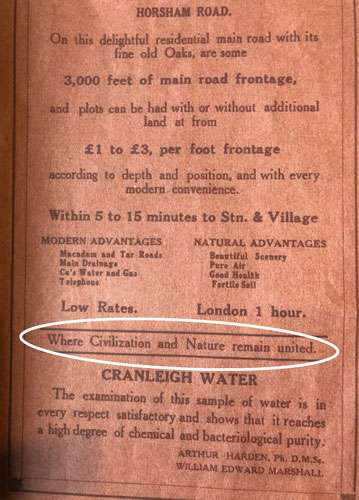
Can these hedgehogs survive in our fast moving world?
I have a copy of a sale brochure produced for A B Johnson, a local developer in the early 1920s – advertising plots for sale along the Horsham Road and stating that this is where ‘CIVILISATION and NATURE REMAIN UNITED’ A dubious claim, even then. One hundred years on and it seems more of a clash between ‘civilisation’ in the form of urbanisation – and Nature.
Along the same lines, with much PR trumpeting, a national firm of developers has announced that they are putting holes at the bottom of their fencing to help hedgehogs. The fencing surrounds the plots of the new- built houses – barren little squares which don’t seem ideal environments for hedgehogs, but given time, perhaps the hedgehogs will adapt. Nature can be resilient.
By contrast, a local friend of mine was recently able to buy a piece of woodland at the end of his garden – and has set it up as a hedgehog haven. He has resident hedgehogs but also is ‘adopting’ hedgehogs from a local wildlife charity – with the view to enabling them, when they are ready, to lead an independent life.
The 1920s advert selling plots of land on the Horsham Road
As you can see from the photo on the right, he has left wild areas for cover, installed hedgehog houses and hidden them beneath brash, piled up logs and dug a hedgehog friendly pond with sloping sides for easy access.
Hedgehogs are nocturnal hunters – emerging at dusk to snuffle – sometimes quite loudly – for beetles and worms. They are popular with gardeners as they will also eat slugs, snails and caterpillars. In fact, they are regularly voted ‘Britain’s favourite garden mammal’.
I remember some years ago that the advice was to leave milk and bread out for hedgehogs in your garden. This advice is now strongly contradicted, as it will harm the creatures. How did they get that so wrong? Tinned cat or dog food is on the menu now – and there is a special hedgehog food called appropriately ‘Spike’. Hedgehogs have developed these stiff sharp spines for self-defence. Each animal has about 7,000 of them covering back, sides and top of the head.

My friend’s garden showing his extended plot
Hibernation usually lasts from October to April – but this depends on the weather. The current advice is that if you see a hedgehog during the winter period the creature could well be in trouble. Take it in (wearing gloves), keep it warm, if possible offer some pet cat or dog food and contact Hydestile Resident Animals.
My son and family live in Bristol and due to a house-buying chain going awry, they are in a rented house for a while in the suburbs of the city. When I saw photos of the garden, it looked like an archaeological dig. The landlord assured us that it was a badgers’ sett. Everyone was very excited – and a night camera was set up. We weren’t sure there would be anything to see – as badgers don’t come out much in the winter. On the second night the camera caught a creature ambling about in their garden with that characteristic black and white face marking. My family may still be in that house during the spring, and if they are lucky, they might catch sight of the new cubs.
Perhaps, after all, Civilisation and Nature can co-exist, sometimes. We hope to tilt the balance in favour of Nature at Beryl Harvey Conservation Site.

A nice pond gives added interest and attracts wildlife
For further information: visit our conservation site in Cranleigh –
or better, volunteer. Contact Philip Townsend at: townsendp99@gmail.com for details.












